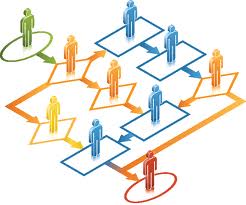 Your job is harder than mine. Although I am a CEO, responsible for daily operations for both my own business and that of my clients, this statement still has the potential for truth due to the systems and processes I have put in place.
Your job is harder than mine. Although I am a CEO, responsible for daily operations for both my own business and that of my clients, this statement still has the potential for truth due to the systems and processes I have put in place.
A process is a series of steps that result in a service or a product. A process includes inputs that are transformed into outputs. From inputs to outputs, a process can be shown visually through a process map. Understanding processes and improving them in an effort to reduce problems, defects, waste, etc. is an important component of Six Sigma methodology. In an organization, processes are assigned to a Process Owner who makes sure that inputs and steps are properly implemented. A Process Owner must have enough authority to make decisions. This person also can be a team leader and is responsible for the outcome of processes within projects. A Process Owner reports to a Senior Manager. In a process, feedback is critical to determine which steps in the process are not effective or efficient.
Most problems in a business system are caused by a lack of effective processes being implemented. A process is a step-by-step guide that produces a desired result. Business process management is a method of implementing, measuring, and facilitating various processes so that work flows as smoothly—and profitably—as possible.
All successful craftspeople, professionals, managers, and sales people use a process—often without realizing it. A skill is learned by following another person’s process—whether it is on-the-job training, learning in class or self-taught by reading books and manuals.
For example, an apprentice watches a skilled carpenter proceed through the processes of carpentry work. The apprentice listens to the carpenter’s explanations and asks questions about the processes. The apprentice then learns to read blue prints, develop math skills and operate tools. Each acquired skill involved understanding the processes that were being used.
Processes have several components such as:
• Timing
• Costs
• Standards for product, performance, or employees
• Quality
• Skills
Timing is how long it takes to complete the sequence of steps. Costs may include raw materials, labor, management, or equipment. Standards are specifications; like how the end product will look, what special tools are needed, or how the workers should conduct themselves. The quality component addresses issues like customer satisfaction and the product’s enhanced appearance/improved performance. The skills component might deal with defining the skill level needed by employees to complete the process successfully.
The critical step to success. If a process is written in a manual, all employees can follow the same steps and get a similar result each time. In addition, the people who wrote the process can use the manual as a reference guide. Documenting the processes provides consistency and as modifications or improvements are made, it is easy to update the manual. Together, process documentation and the workforce create a reliable result.
Processes on a grand scale. Sometimes, it requires several processes to obtain a particular result. A system uses numerous processes to meet its objective in a large arena; such as the marketing and lead generation systems.
Picture it on a map. A process map helps keep track of the processes that are needed in order to keep a system functioning. The map is a visual diagram of a process that illustrates:
- Tasks accomplished by position and sequence
- Hand-offs between functions, departments, or individuals
- Internal and outsourced operational limits or boundaries
- Start and stop points
A process map is developed to first better understand and locate gaps—such as high cost, decreased production, or poor quality/service—in any key business area. Secondly, process maps draw a picture of what a process looks like so that people can understand it faster and better.
Drawing the map. To design a customized map for your business, contact us today!
After you have developed a process map of how the task is currently performed, you can analyze it for improvement. Are there any steps that can be eliminated? Do you need to change the current sequence? Do you need to add steps?
Many companies have great products and services, but small businesses don’t usually take the time to develop all of the critical processes that are necessary to achieve maximum success. This isn’t because Owners and Managers don’t want to grow; it is because they have never received interactive management and marketing process training. That is all about to change. When you use process maps, you have the tool necessary to innovate and create the business of your dreams.
Don’t struggle another day, contact Holt Marketing and Management Services, Inc. today to streamline your processes and make your job easier! Click the button below or call 989-791-2475 ext. 13 for more information.



